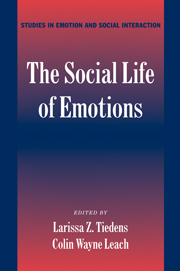Book contents
- Frontmatter
- Contents
- Acknowledgements
- List of Contributors
- The Social Life of Emotions
- Introduction: A World of Emotion
- PART I THE INTERPERSONAL CONTEXT
- 1 Empathy
- 2 Envy and Its Transmutations
- 3 The Bond Threat Sequence
- 4 Emotion as Adaptive Interpersonal Communication
- 5 Does Expressing Emotion Promote Well-Being? It Depends on Relationship Context
- PART II THE INTRAGROUP CONTEXT
- PART III THE INTERGROUP CONTEXT
- Index
- References
3 - The Bond Threat Sequence
Discourse Evidence for the Systematic Interdependence of Shame and Social Relationships
Published online by Cambridge University Press: 01 April 2011
- Frontmatter
- Contents
- Acknowledgements
- List of Contributors
- The Social Life of Emotions
- Introduction: A World of Emotion
- PART I THE INTERPERSONAL CONTEXT
- 1 Empathy
- 2 Envy and Its Transmutations
- 3 The Bond Threat Sequence
- 4 Emotion as Adaptive Interpersonal Communication
- 5 Does Expressing Emotion Promote Well-Being? It Depends on Relationship Context
- PART II THE INTRAGROUP CONTEXT
- PART III THE INTERGROUP CONTEXT
- Index
- References
Summary
During the last decade there has been increasing attention to “social affect” as a category of emotion strongly associated with the assessment, formulation, and management of social relationships. There is a constant need during social interactions for individuals to evaluate the quality of the interpersonal association. A system of emotions devoted to the quality of “being social” may therefore be most visible when individuals encounter problems involving social relationships. Methods for examining the dynamics of social affect should also capture in detail their integration with the discourse in which they arise. Such methods, however, constitute an almost invisible fraction of the widening literature on social affect. By examining emotions and relationships as they occur, direct analysis of discourse allows exploration of social affect outside the confines of predetermined variables, scenarios, and participants' self-reports on scales.
This chapter presents evidence of a systematic link between social affect and the quality of social relationships. Specifically, it tests and expands Retzinger and Scheff's theory that shame represents a category of social emotion dedicated to maintaining social relationships and sociality among individuals and groups. Methods for analyzing the integration of conversation with affect and relationships are presented and illustrated in detail, and applied to an interview setting in which participants explain their answers to a standard self-evaluation scale. Analysis of discourse found that participants often display in speech and gesture varieties of shame.
- Type
- Chapter
- Information
- The Social Life of Emotions , pp. 64 - 86Publisher: Cambridge University PressPrint publication year: 2004
References
- 9
- Cited by



